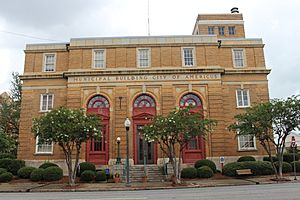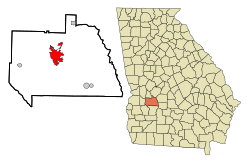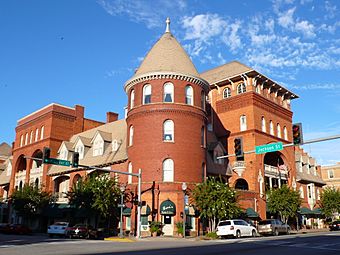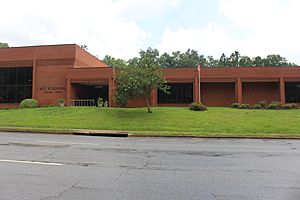Americus, Georgia facts for kids
Quick facts for kids
Americus
|
|||
|---|---|---|---|

Municipal Building in Americus
|
|||
|
|||

Location in Sumter County and the state of Georgia
|
|||
| Country | United States | ||
| State | Georgia | ||
| County | Sumter | ||
| Area | |||
| • Total | 11.57 sq mi (29.96 km2) | ||
| • Land | 11.35 sq mi (29.40 km2) | ||
| • Water | 0.22 sq mi (0.57 km2) | ||
| Elevation | 479 ft (146 m) | ||
| Population
(2020)
|
|||
| • Total | 16,230 | ||
| • Density | 1,429.96/sq mi (552.13/km2) | ||
| Time zone | UTC-5 (Eastern (EST)) | ||
| • Summer (DST) | UTC-4 (EDT) | ||
| ZIP codes |
31709, 31710, 31719
|
||
| Area code(s) | 229 | ||
| FIPS code | 13-02116 | ||
| GNIS feature ID | 0331037 | ||
Americus is a city in Georgia, United States. It is the main city of Sumter County. In 2020, about 16,230 people lived there. Americus is also the center of a larger area called the Americus Micropolitan Statistical Area. This area includes Sumter and Schley counties.
Americus is home to the international headquarters of Habitat for Humanity. It also hosts The Fuller Center for Housing and Georgia Southwestern State University. The famous Windsor Hotel is located here. The city has a rich history. It is close to the Jimmy Carter National Historical Park and the Andersonville National Historic Site.
Contents
Exploring Americus History
How Americus Started
Americus was founded by General John Americus Smith. He bought land in 1825 and started a large cotton farm. More people moved to the area, and the town of Americus was officially started in 1832. General Smith's farm helped the town grow and earn money.
For its first 20 years, Americus was a small town with a courthouse. In 1854, the railroad arrived, which helped the city grow a lot. By the early 1900s, Americus became the eighth largest city in Georgia. It was known as the "Metropolis of Southwest Georgia" because it was a big center for cotton.
In 1890, Georgia's first electric street car system began operating in Americus. One of these old street cars is now on display at the Lake Blackshear Regional Library.
Famous Buildings and People
Americus has many beautiful old buildings, including antebellum and Victorian architecture styles. The Windsor Hotel opened in 1892. It is a five-story building designed by a Swedish architect. Important people like Vice-President Thomas R. Marshall and future New York Governor Franklin D. Roosevelt gave speeches there.
The city center of Americus was added to the National Register of Historic Places in 1976. This means it is a special place with important history.
Education and Aviation History
In the early 1900s, several important schools were started in Americus. The Americus Institute was founded in 1897. Booker T. Washington spoke there in 1908. The Third District Agricultural and Mechanical School opened in 1906. Today, this school is known as Georgia Southwestern State University.
Another school, the South Georgia Trade and Vocational School, opened in 1948. It is now called South Georgia Technical College. This college is on the site of an old airfield called Souther Field.
Souther Field was an important training facility during World War I and World War II. In 1923, Charles Lindbergh, the famous pilot, bought his first airplane and flew solo for the first time at Souther Field.
Americus and Civil Rights
Koinonia Farm, a Christian community where people of all races lived together, was started near Americus in 1942. The founders of Habitat for Humanity, Millard and Linda Fuller, were inspired by Koinonia Farm. They started Habitat for Humanity International there in 1976. Later, they moved its headquarters to Americus. In 2005, they also founded The Fuller Center for Housing in Americus.
The Civil Rights Movement brought many changes to Americus. Dr. Martin Luther King Jr. was held in the courthouse jail in 1961. In 1963, the "Sumter Movement" worked to end racial segregation in the city. As a result, two Georgia laws were found to be against the constitution.
In 1965, J.W. Jones and Henry L. Williams became the first black police officers in Americus. Ten years later, Lewis M. Lowe was elected as the first black city councilman. In 1995, Eloise R. Paschal and Eddie Rhea Walker became the first women elected to the city's governing body.
Where is Americus?
Americus is located at 32°4′31″N 84°13′36″W / 32.07528°N 84.22667°W.
The city covers about 10.7 square miles (27.7 square kilometers). Most of this area is land, with a small part being water.
Americus Population
The population of Americus has changed over the years. Here's how it has grown:
| Historical population | |||
|---|---|---|---|
| Census | Pop. | %± | |
| 1870 | 3,259 | — | |
| 1880 | 3,635 | 11.5% | |
| 1890 | 6,398 | 76.0% | |
| 1900 | 7,674 | 19.9% | |
| 1910 | 8,063 | 5.1% | |
| 1920 | 9,010 | 11.7% | |
| 1930 | 8,760 | −2.8% | |
| 1940 | 9,281 | 5.9% | |
| 1950 | 11,389 | 22.7% | |
| 1960 | 13,472 | 18.3% | |
| 1970 | 16,091 | 19.4% | |
| 1980 | 16,120 | 0.2% | |
| 1990 | 16,512 | 2.4% | |
| 2000 | 17,013 | 3.0% | |
| 2010 | 17,041 | 0.2% | |
| 2020 | 16,230 | −4.8% | |
| U.S. Decennial Census 1850-1870 1870-1880 1890-1910 1920-1930 1940 1950 1960 1970 1980 1990 2000 2010 |
|||
In 2020, there were 16,230 people living in Americus. There were 6,162 households and 3,557 families.
Local Economy
Americus has several large employers that provide jobs for many people.
Top Employers in Americus
Here are some of the biggest employers in the area:
| # | Employer | # of employees |
|---|---|---|
| 1 | Sumter County Schools | 950 |
| 2 | Eaton Cooper Lighting | 600 |
| 3 | Habitat for Humanity | 400 |
| 4 | Wal-Mart | 399 |
| 5 | Phoebe Sumter Medical Center | 396 |
| 6 | Magnolia Manor | 375 |
| 7 | Georgia Southwestern State University | 280 |
| 8 | Southern Star Community Services | 253 |
| 9 | Sumter County | 235 |
| 10 | City of Americus | 195 |
Schools and Learning
Americus has many schools for students of all ages.
Schools for Younger Students
The Sumter County School District manages schools from pre-school to twelfth grade. There are about 353 full-time teachers and over 5,774 students.
- Sumter County Primary School
- Sumter County Elementary School
- Sumter County Intermediate School
Schools for Older Students
- Sumter County Middle School
- Americus-Sumter Ninth Grade Academy
- Americus-Sumter County High School
There is also a K-12 charter school called Furlow Charter School. For private education, there is Southland Academy.
Colleges and Universities
- Georgia Southwestern State University
- South Georgia Technical College
All these schools and colleges are approved by the Southern Association of Colleges and Schools (SACS).
Public Libraries
The community has the Lake Blackshear Regional Library. It is part of the Lake Blackshear Regional Library System. The library was rebuilt after a tornado in 2007 and moved back to its original location around 2012.
Fun Places to Visit
Americus and the surrounding area offer several interesting places for visitors:
- Georgia Rural Telephone Museum - located in Leslie
- Georgia Veterans State Park - near Lake Blackshear
- Jimmy Carter National Historic Site - located in Plains
- Habitat for Humanity Global Village and Discovery Center - located in Americus
Baseball History
Americus has a history with minor league teams. Eight different teams have played in the city over 20 seasons, from 1906 to 2002. Many players from Americus teams later played in Major League Baseball.
Famous People from Americus
Many notable people have connections to Americus:
- Griffin Bell
- Mike Cheokas - politician
- Brent Cobb
- Howell Cobb
- Philip Cook
- Charles F. Crisp
- Charles R. Crisp
- Cassandra Pickett Durham
- Lonne Elder III
- Millard Fuller
- Chan Gailey
- Jimmy Garrison
- Victor Green
- Dr. Shirley Green-Reese
- Kent Hill
- George Hooks
- Alonzo Jackson
- Eddie Jackson
- Otis Leverette
- Angel Martino
- Joanna Moore
- Ruby Muhammad
- James Nabrit Jr.
- Leonard Pope
- Dan Reeves
- Mo Sanford
- Emma Lane - Inventor of the Lane Cake
Images for kids
See also
 In Spanish: Americus (Georgia) para niños
In Spanish: Americus (Georgia) para niños






